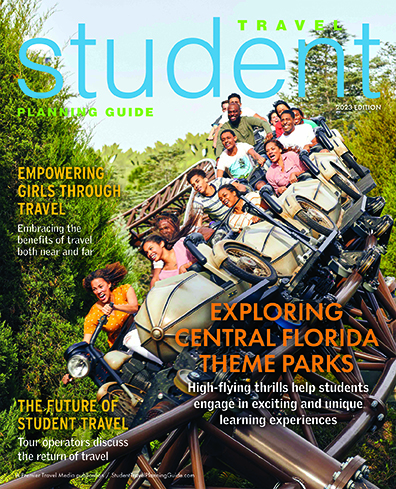Washington, D.C. may not be the first destination you think of when planning a STEM-centric student tour. After all, our nation’s capital is most-visited for its historic landmarks, government buildings and priceless art. However, Washington, DC boasts as many engaging and affordable STEM attractions as any city in North America, and Brightspark Travel works diligently to craft custom Washington, D.C. tours that feature adventures from aviation to zoology, igniting your students’ curiosity and imagination. Brightspark handles all the details, including payments for group meals, lodging and attraction tickets, leaving you more time to savor the trip and your students’ enjoyment.
After your group settles in at a Brightspark-arranged hotel, begin by meeting your designated tour director for an adventure inside the Smithsonian National Museum of Natural History. The world’s most popular natural history museum is larger than 18 football fields and houses an enormous collection for students eager to explore. Group members will especially enjoy the Hall of Human Origins (which explores man’s evolution from East African primates), Ocean Hall (where a North Atlantic whale and giant squid hang from the ceiling) and the Hall of Paleobiology (a cavernous space that houses dozens of dinosaur skeletons).

Continue along the National Mall to the United States Botanic Garden, one of the largest enclosed gardens in the world and home to constantly rotating exhibitions that encourage farming sustainability and biodiversity. Permanent exhibits include the Conservatory (an immense collection of subtropical plants that can trace their origins to the Jurassic period) and the National Garden (which showcases plants from American regions), while the upcoming Gardens Across America exhibition will showcase the diversity of America’s 600 public gardens (coming in summer 2019). Resident naturalists can create custom tours that spotlight flowers and plants native to your student’s home state.
On day two, students can explore one of Washington’s signature attractions: the National Air & Space Museum. This hall houses iconic aircraft like the 1903 Wright Flyer, Charles Lindbergh’s Spirit of St. Louis and the Apollo 11 command module, and various exhibits spotlight spacecraft, World War II aviation and flight in fiction. Students will especially enjoy “How Things Fly,” which features dozens of hands-on stations that invite visitors to push, lift and manipulate objects to learn the basic physics of flight. Next, the National Museum of African American History & Culture will compel students with an interest anthropology. Washington, D.C.’s newest museum is a sobering and celebratory examination of 400 years of African American culture in the United States, and artifacts include Harriet Tubman’s hymnal, Nat Turner’s bible and works by prolific artists such as Charles Aston and Romare Bearden. Students will then spend their evening at the National Aquarium in Baltimore, which houses over 17,000 animals and also features a 4D immersion theater, tactile exhibits and a 35-foot-tall waterfall. Groups can choose from three overnight experiences: Dolphin Overnight, Aquarium Adventure or Shark! Ocean Predator Overnight. Students will be treated to a meal and can explore various exhibits after-hours with the accompaniment of a knowledgeable guide before sleeping ”under the sea!”

The next morning, student groups will stop at the National Cryptologic Museum adjacent to the NSA headquarters in Maryland. This space profiles security and spycraft throughout American history, from the cipher devices used during the Revolutionary War to cybersecurity technology implemented today. Student tours will cover how hidden messages were sent during the Civil War, how mathematicians cracked the code for the German Enigma and the lives of Navajo Code Talkers during World War II. Groups then travel south to Silver Springs, Maryland, home of the National Museum of Health and Medicine. The museum’s five collections house millions of artifacts, and tours can be tailored to groups with a particular medical or pharmaceutical interest. Highlights include primitive x-ray equipment, advances in military medicine and items related to Abraham Lincoln’s assassination at the hand of John Wilkes Booth.
Spend the afternoon in the National Zoo, which houses giant pandas, great apes, Asian elephants and thousands of other species. Venture into Amazonia for up-close looks at the exotic fish that thrive in the South American rainforest, view majestic lions and tigers in the Big Cat area and teach students the basics of species preservation at the Cheetah Conservation Station. Brightspark can also arrange specialty tours for groups with a particular biological or zoological interest, such as Wildlife Trafficking (which educates students on the dangers of poaching). Day three concludes with a leisurely tour of the Tidal Basin and stops at famous sites such as the Thomas Jefferson Memorial, the Franklin Delano Roosevelt Memorial and the Martin Luther King, Jr. Memorial.

Budding engineers in your student group will enjoy the first stop on your final day: the KID Museum. Encouraging creativity and critical thinking in the fields of design, electronics and coding, the space is a hybrid of an artist studio and museum. Groups can register for 90-minute workshops that focus on a particular design discipline, and students are encouraged to create personal designs using woodworking, electric circuits and robotics. The final stop on your Brightspark tour is the International Spy Museum. Dedicated to the tradecraft, history and contemporary role of espionage, the museum sheds a light on the impact espionage has had on world events, politics and the current state of our nation. The museum houses seven permanent exhibits, which include “School for Spies,” where students examine more than 200 gadgets, weapons, bugs, cameras, vehicles and technologies; “The Secret History of History,” where students uncover the stories of espionage throughout the ages; and “Weapons of Mass Disruption,” where they learn about the use of cyberspace in espionage.
Whether your students are interested in medicine, marine biology or American history, Washington, D.C. is filled with fascinating museums and landmarks to explore. Brightspark will offer a peerless student travel experience that integrates attractions and activities into a STEM adventure your school group will never forget.






